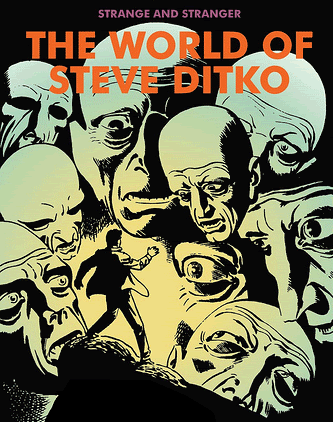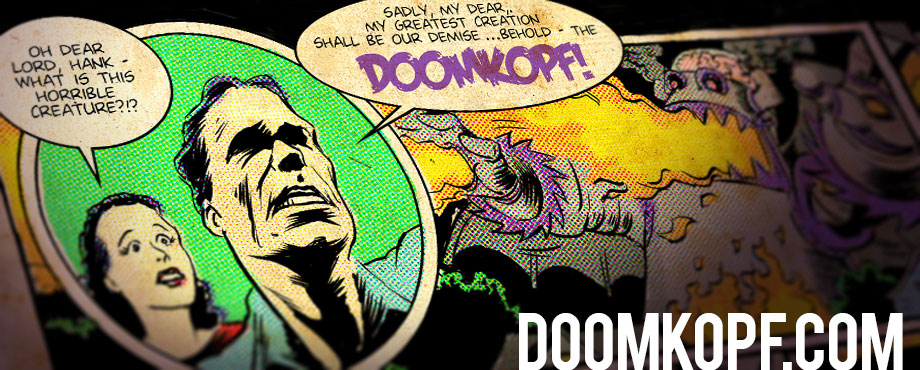Strange and Stranger:
The World of Steve Ditko
By Blake Bell
Published by Fantagraphics Books, 2008; 220 pages; $39.99
 “Strange and Stranger” by Blake Bell is an intriguing biography in the life, career and politics of Steve Ditko, best well-known in the pop-culture world as the co-creator of Spider-Man, but also creator of several other characters like Dr. Strange, The Question, Captain Atom and the Ted Kord Blue Beetle.
“Strange and Stranger” by Blake Bell is an intriguing biography in the life, career and politics of Steve Ditko, best well-known in the pop-culture world as the co-creator of Spider-Man, but also creator of several other characters like Dr. Strange, The Question, Captain Atom and the Ted Kord Blue Beetle.
Bell dives into Ditko’s early years in comics, when he scraped by doing whatever paying work he could get. In those days, before the Silver Age superhero boom, much of that work was in horror comics.
“I have a fondness for his pre-superhero Marvel material,” Bell told me. “Those 5-page, Twilight Zone-ending stories that just drip Ditko atmosphere.”
Around this time in his early career, Ditko was exposed to Ayn Rand and the moral and political philosophy of Objectivism that sprang from her work, and for much of the second half of the book, Bell illustrates how Ditko’s creative output would never be the same. A rigid outlook on right and wrong, producers and consumers and justice and punishment steered Ditko’s career into obscurity, and his comic creations ended up becoming a grotesque autobiographical document of the man’s descent into a harshly judgmental, self-imposed isolation.
A healthy sampling of Ditko’s early work is presented in the book, showing the evolution of his style as he built confidence and started developing some of his storytelling techniques.
“I chose every image because I wanted to comment on those images and have them represent the arc of Ditko’s career,” Bell said.
The visual aides are without a doubt one of the best parts of the book. True to comic form, the art functions as a story of its own as it also illuminates points Bell makes in his text. Given Ditko’s beliefs, it’s no small irony that much of this work is now in the public domain.
Ditko’s adherence to a black and white morality is clearly presented as being far more situational than he might wish. He appears to be unafraid to lie about events, provided the lie paints a picture of the past more in line with his Objectivist beliefs, whether it’s Ditko’s relationship and collaborations with fetish / bondage artist Eric Stanton or the “intellectually dishonest” accounts of his relationship with Bell in the events that led up to the creation of the biography.
Ditko also had his falling out with Marvel over his Objectivist conclusion that others were reaping the credit and financial benefits over his work as a producer, yet later in his career, he apparently had no problem getting paid and credited for rushed and incomplete pencils — work that was so insufficient that others had to do his work for him for no extra credit or pay.
I read these acts not as those of a morally consistent man, but as an insecure individual looking to cover up his failings with a rigidly unforgiving belief system rather than confronting them, but Bell doesn’t feel that’s the case.
“I don’t see him as insecure,” Bell told me. “He just had a particular set of beliefs that he stuck to through thick and thin. He was pretty secure in believing this would get him through life and it did; it just didn’t take him down a path that we wanted him to go, i.e. more Spider-Man and Dr. Strange stories, more getting kicked in the teeth by the same companies that were making millions off his ideas.”
Again, Ditko clearly felt it was wrong for Marvel to take his credit and money, and that justified screwing over the other artists who had to cover for his lack of professionalism later on. But Bell presents some damning quotes from Ditko that show the man’s refusal to believe in redemption; empathy for a wrongdoer was seen as one of the primary ills of society. So rather than admit his own failings, Ditko created lies that allowed him to live up to his “heroic” ideal.
The history of comics is not without its share of double-talking con-men, and while Bell’s presentation of Ditko is pretty even-handed, “Strange and Stranger” makes no effort to paint a rosy picture of Stan Lee. Bell’s narrative pulls no punches when it comes to Lee’s place in history, particularly as relates to the creation of Spider-Man and the lies Lee told to try to secure the credit for himself.
Tom Spurgeon referred to the chapter on Spider-Man as “…the best treatise on the subject he had ever read,” and Bell illustrates the undeniable impact Ditko had on the character — whether it was rescuing it from Jack Kirby’s dismal rehashing of a character he’d worked on a few years earlier or Stan Lee’s efforts to make the character as fantastic and supernatural as possible. Ditko’s insistence on grounding Spider-Man made for a gripping power struggle. Ditko’s paychecks may have suggested Marvel won; the enduring Spider-Man mythology at least gives Ditko a moral victory.
It was interesting to read the delicate way in which people spoke of Kirby in the book, particularly considering how Stan Lee was thoroughly thrown under the bus. For example, Bell quotes artist Paul Smith as saying, in regards to Kirby, “…when you draw Ben Grimm reaching for the salt with the same intensity as you draw Armageddon, it lacks the impact Ditko could create.” But even that slight insult was prefaced with an “I acknowledge that Kirby is the King…”
“There are people, like myself, who appreciate Ditko more than they do Kirby, and some Kirby lovers are very protective of Jack’s legacy, so you sometimes feel like you have to walk a bit gingerly when putting your view point forward about ‘Ditko vs. Kirby,'” Bell explained to me. “It’s a sign of respect more than anything, and both Kirby and Ditko deserve that respect.”
“I don’t think this book was a particularly good place to criticize Kirby,” he added. “He and Ditko admired each other quite a bit by all counts, and Kirby didn’t play much of a direct part in the drama that was Ditko vs. Marvel.” Kirby’s other main arc in this book is of a creator who got his overdue credit and compensation, but was seen as dropping the cause for everyone else once he got his.
While Ditko’s Marvel work is certainly his most well-known, Bell spends quite a bit of time writing about his very personal and extremely Objectivist character, Mr. A. As Ditko tried in vain to impose Objectivism on mainstream superheroes, he eventually hopped from one publishing outlet to another, often unpaid, in order to tell these Objectivist stories.
Bell explains how Ditko backed himself into a professional corner by becoming very particular about his work, refusing to be edited or have his work changed in any way. Unfortunately, he was simultaneously exposing himself for being fairly limited, particularly when it came to making comics that were actually readable, and therefore in more dire need of editing.
Bell told me he was surprised to learn of the degree to which Ditko stuck to his beliefs, “…how much effort he put into trying to bring his vision to an industry that didn’t even have the proper model at the time to sustain what he wanted to do; and how much of a price he paid for that,” he said.
Ditko’s path results in a narrative that, in spite of Bell’s best efforts, fizzles away. There are interesting points made about creator-owned comics, but the story of his career has approached a frustrating end, and Bell is not shy about sharing that frustration. It is here also that I read a little more insecurity than Bell seems to have intended, as it seems more like Ditko’s paranoia than pure Objectivism that keeps him from returning to the industry.
The Grade: A
Ditko’s story is fascinating, even as it tapers off, and this book would even be worth reading for the comic art alone.
There are a few areas that read a little rough, particularly in the use of direct quotes, but the prose is fluid and inviting. I would have liked some coding between the text and the visuals, as some pieces that Bell refers to are immediately available on the same page, but others don’t show up for pages later, and by then you’ve occasionally forgotten the context in which he mentioned them if you even recognize the art from the description. At worst, that forces you to read some of the text again and revisit the art, so it’s a chore that’s worth suffering through. There are also dozens of bonus art pages at the end of the book, including a cover gallery and some samples of Ditko’s creative process.
Beyond the biography of one creator, “Strange and Stranger” also does a great job of illuminating a fascinating period in comics history. That transitional period from horror to the rebirth of the superheroes was a significant moment in the industry, and Bell tells it from the perspective of people who were there. The information is well-documented in the endnotes (which also includes some small stories of its own). Beyond that, Bell said, “I’m sure I could have provided even more ‘Ditko minutiae’ in the Endnotes, but perhaps that’s best, and the reason, for my web site.”
That website is www.ditko.comics.org, and it is definitely worth checking out.
